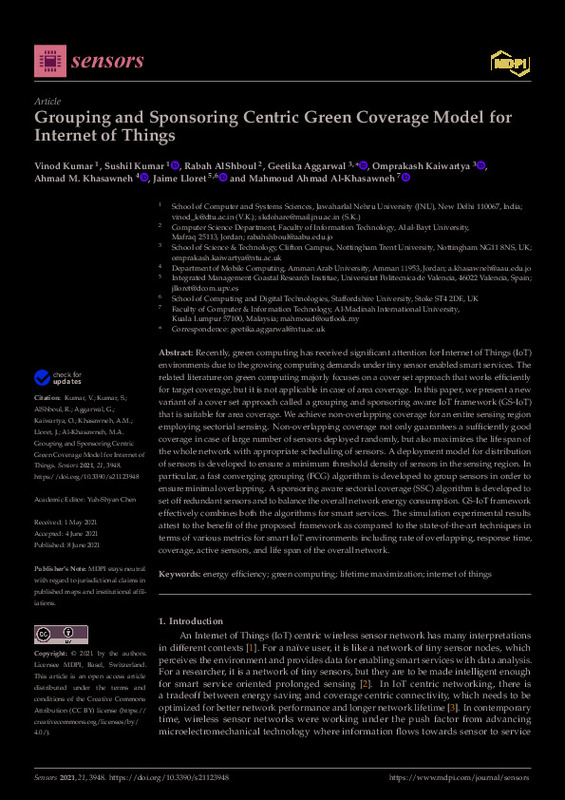JavaScript is disabled for your browser. Some features of this site may not work without it.
Buscar en RiuNet
Listar
Mi cuenta
Estadísticas
Ayuda RiuNet
Admin. UPV
Grouping and Sponsoring Centric Green Coverage Model for Internet of Things
Mostrar el registro sencillo del ítem
Ficheros en el ítem
| dc.contributor.author | Kumar, Vinod
|
es_ES |
| dc.contributor.author | Kumar, Sushil
|
es_ES |
| dc.contributor.author | AlShboul, Rabah
|
es_ES |
| dc.contributor.author | Aggarwal, Geetika
|
es_ES |
| dc.contributor.author | Kaiwartya, Omprakash
|
es_ES |
| dc.contributor.author | Khasawneh, Ahmad M.
|
es_ES |
| dc.contributor.author | Lloret, Jaime
|
es_ES |
| dc.contributor.author | Al-Khasawneh, Mahmoud Ahmad
|
es_ES |
| dc.date.accessioned | 2022-10-13T18:07:24Z | |
| dc.date.available | 2022-10-13T18:07:24Z | |
| dc.date.issued | 2021-06-08 | es_ES |
| dc.identifier.uri | http://hdl.handle.net/10251/187692 | |
| dc.description.abstract | [EN] Recently, green computing has received significant attention for Internet of Things (IoT) environments due to the growing computing demands under tiny sensor enabled smart services. The related literature on green computing majorly focuses on a cover set approach that works efficiently for target coverage, but it is not applicable in case of area coverage. In this paper, we present a new variant of a cover set approach called a grouping and sponsoring aware IoT framework (GS-IoT) that is suitable for area coverage. We achieve non-overlapping coverage for an entire sensing region employing sectorial sensing. Non-overlapping coverage not only guarantees a sufficiently good coverage in case of large number of sensors deployed randomly, but also maximizes the life span of the whole network with appropriate scheduling of sensors. A deployment model for distribution of sensors is developed to ensure a minimum threshold density of sensors in the sensing region. In particular, a fast converging grouping (FCG) algorithm is developed to group sensors in order to ensure minimal overlapping. A sponsoring aware sectorial coverage (SSC) algorithm is developed to set off redundant sensors and to balance the overall network energy consumption. GS-IoT framework effectively combines both the algorithms for smart services. The simulation experimental results attest to the benefit of the proposed framework as compared to the state-of-the-art techniques in terms of various metrics for smart IoT environments including rate of overlapping, response time, coverage, active sensors, and life span of the overall network. | es_ES |
| dc.description.sponsorship | This research was partially supported by the Al al-Bayt University, Jordan, and partially by the Jawaharlal Nehru University, New Delhi, India. | es_ES |
| dc.language | Inglés | es_ES |
| dc.publisher | MDPI AG | es_ES |
| dc.relation.ispartof | Sensors | es_ES |
| dc.rights | Reconocimiento (by) | es_ES |
| dc.subject | Energy efficiency | es_ES |
| dc.subject | Green computing | es_ES |
| dc.subject | Lifetime maximization | es_ES |
| dc.subject | Internet of things | es_ES |
| dc.subject.classification | INGENIERIA TELEMATICA | es_ES |
| dc.title | Grouping and Sponsoring Centric Green Coverage Model for Internet of Things | es_ES |
| dc.type | Artículo | es_ES |
| dc.identifier.doi | 10.3390/s21123948 | es_ES |
| dc.rights.accessRights | Abierto | es_ES |
| dc.contributor.affiliation | Universitat Politècnica de València. Departamento de Comunicaciones - Departament de Comunicacions | es_ES |
| dc.description.bibliographicCitation | Kumar, V.; Kumar, S.; Alshboul, R.; Aggarwal, G.; Kaiwartya, O.; Khasawneh, AM.; Lloret, J.... (2021). Grouping and Sponsoring Centric Green Coverage Model for Internet of Things. Sensors. 21(12):1-21. https://doi.org/10.3390/s21123948 | es_ES |
| dc.description.accrualMethod | S | es_ES |
| dc.relation.publisherversion | https://doi.org/10.3390/s21123948 | es_ES |
| dc.description.upvformatpinicio | 1 | es_ES |
| dc.description.upvformatpfin | 21 | es_ES |
| dc.type.version | info:eu-repo/semantics/publishedVersion | es_ES |
| dc.description.volume | 21 | es_ES |
| dc.description.issue | 12 | es_ES |
| dc.identifier.eissn | 1424-8220 | es_ES |
| dc.identifier.pmid | 34201100 | es_ES |
| dc.identifier.pmcid | PMC8226805 | es_ES |
| dc.relation.pasarela | S\473226 | es_ES |








